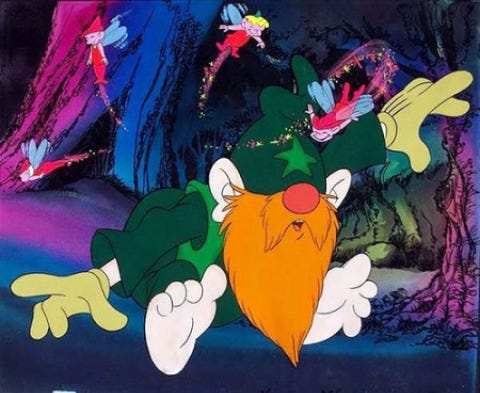Wizards (1977)

Having recently reviewed Ralph Bakshi's "The Lord of the Rings" for its Blu-ray release, I thought I'd go a little deeper into his oeuvre to see if I could figure out why his style seemed so ill-suited to adapting Tolkien's masterwork.
I saw "Fritz the Cat" years ago -- so long I barely remember it. Ditto for "Wizards," made in 1977, the year immediately before "LOTR." Wizards has a lot of thematic similarities to "LOTR" -- an ancient world of faerie magic in which the forces of good and evil battle for final dominion over all the land.
It's probably no surprise, then, that I was also disappointed while re-watching "Wizards." Actually, I fracking hated the thing. And I think I figured out why I'm not a Bakshiite.
Ralph Bakshi did not make animated films. He made cartoons.
I'm not trying to be dismissive here. Many of my favorite films are cartoons. You don't even have to be animated to be one. "Kick-Ass," given a very favorable review by me, is explicitly and joyously a cartoon.
Nothing wrong with being a cartoon. The problem comes in that Bakshi approaches material that would better be served by being taken seriously in a way that is unserious, flip and ... well, cartoonish.
Let me define my terms. To me, a cartoon is something that doesn't take its subject at face value. Everything it presents is on some level being ridiculed or undermined. Even Bugs Bunny got his comeuppance from time to time. If a cartoon shows you a noble hero on a quest to save a damsel, you know he's going to do something silly before long.
It's pretty obvious why I -- and most fans of Tolkien's "Lord of the Rings" -- didn't like this sensibility applied to a world and characters that we so cherished. But I think it ends up ruining "Wizards" as well.
"Wizards" opens with a prologue that presents a world (ours) destroyed by nuclear holocaust. Millions of years later, the Eath is occupied by mutants and faerie creatures. The leaders of the two opposing factions are great wizards, brothers who despise each other: Avatar and Blackwolf.
(With names like that, I don't think I need bother saying which is evil and which is good.)
Now, with a premise like that, you're expecting some pretty grim stuff. But the film opens with Bakshi's trademark puckish humor, cutesy depictions of faeries, and a whole lot of cornball action.
When I first laid eyes on Avatar the Old, I wanted to throw up. He has aged into a diminutive figure who wears clownish robes over his pudge-pot torso and a conical wizard hat complete with a star. He has a bulbous red nose, a long beard that hides his face entirely, and goes about barefoot. He's constantly tugging on a stogie that he clutches between his toes. As voiced by veteran voice actor Bob Holt, Avatar talks in a world-weary growl and distinctly Northeastern accent.
So after that great build-up about a post-apocalyptic world filled with beauty and horror, our guide in this journey is basically Mr. Magoo's grumpy cousin from Brooklyn.
Things get worse from there. Avatar doesn't do much magic these days, and has hired himself out to the president of the good kingdom to instruct his daughter, Elinore, on how to become a full-fledged fairy. Right now she's only about halfway there. (Why a fairy born with wings has to be trained to be one is beyond me.)
Necron 99, a red robot sent by Blackwolf to kill believers of magic, executes the president. Avatar uses his power to change the robot's personality to good, and renames him Peace. He, Peace, Elinore and the elf warrior Weehawk set out to Blackwolf's fortress in Scortch to put an end to his evil ways.
Blackwolf's armies are slowly conquering the world through the use of his secret weapon, which turns out to be a film projector running newsreel footage of Nazi Germany. Just by showing this movie of Hitler raving and Panzers rolling, the good armies fall into a stupor and cannot fight.
Now, a lot of logistical problems with that. First of all, it's made explicit that millions of years have passed since nuclear weapons ravaged the planet. Even if any projectors survived the bombing, they would have turned to dust by now. And celluloid film would have disintegrated within a few hundred years, max.
Next, even if this stuff were somehow still around or Blackwolf managed to recreate them, how does he project the images into the sky above his enemies? Again, the movie specifically shows him using a small projector, not even 35 mm. There are no giant screens suspended in the sky. OK, let's say he's just using his magic.
But even if all these other objections didn't exist, why would the simple image of Nazis make soldiers swoon? They don't know who the hell Hitler is or what the Nazis did. They have no context to be horrified by these images. Seeing tanks shells tearing up a battlefield is certainly nothing that would bother hardened fighters used to hand-to-hand combat.
The film (also written by Bakshi) sets up the struggle as an epic one between nature and technology. In the end, of course, when Avatar finally faces Blackwolf in their final showdown, he pulls out a pistol and shoots him.
This is what I mean about cartoonish. Although it's a great laugh moment, it completely undermines everything that came before. Bakshi always seems to fall back on goofy humor and a drawing style inspired by Scooby-Doo. That's not to say that he didn't have a great imagination; his instincts were just more "Fritz the Cat" than "Lord of the Rings."
1.5 Yaps



